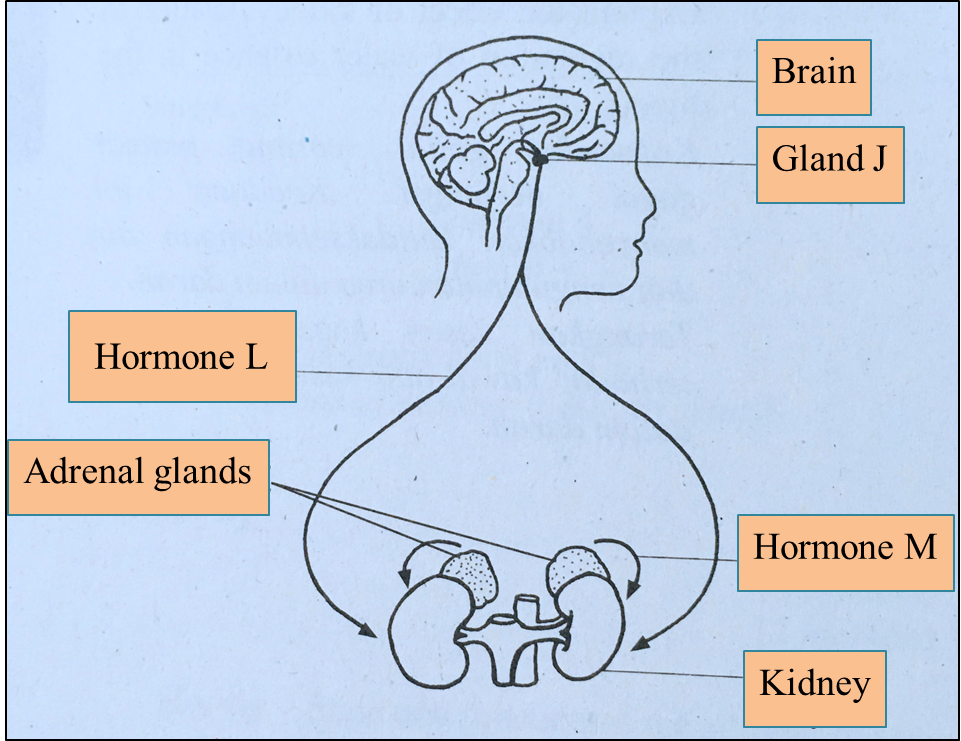[adinserter block="3"]
Question 3:
Diagram 3 shows a human digestive system.
 Diagram 3
Diagram 3
(a)(i) Name gland X. [1 mark]
(ii) Bread contains starch.
Explain the role of gland X in the digestion of bread in P. [3 marks]
(iii) Explain why the process of digestion of bread does not occur in Q. [3 marks]
(b)(i) Name organ R. [1 mark]
(ii) A person has a gallstone as in Diagram 3. Explain the effect of this condition to the digestion of lipid in S. [2 marks]
(c) Explain one difference in the digestion of protein that occurs in Q and S. [2 marks]
[adinserter block="3"]
Answer:
(a)(i)
Salivary gland
(a)(ii)
- Gland X produces saliva
- Saliva contains the salivary amylase enzyme.
- Salivary amylase hydrolyses / digests starch into maltose.
(a)(iii)
- Q (stomach) produces gastric juice.
- Gastric juice contains hydrochloric acid.
- Hydrochloric acid denatures / inhibits the action of salivary amylase. (Hence the digestion of starch in bread is stopped)
(b)(i)
Gall bladder
(b)(ii)
- Gall stone in the bile duct prevents the flow of bile from liver to duodenum.
- Bile emulsifies fat hence with the absence / lower amount of bile, the digestion of lipid is slowed down.
(c)
- In Q (stomach), protein is digested by pepsin enzyme in an acidic medium to form peptides.
- In S (duodenum), peptides are digested by trypsin enzyme in an alkaline medium to form dipeptides.
Diagram 3 shows a human digestive system.
 Diagram 3
Diagram 3 (a)(i) Name gland X. [1 mark]
(ii) Bread contains starch.
Explain the role of gland X in the digestion of bread in P. [3 marks]
(iii) Explain why the process of digestion of bread does not occur in Q. [3 marks]
(b)(i) Name organ R. [1 mark]
(ii) A person has a gallstone as in Diagram 3. Explain the effect of this condition to the digestion of lipid in S. [2 marks]
(c) Explain one difference in the digestion of protein that occurs in Q and S. [2 marks]
[adinserter block="3"]
Answer:
(a)(i)
Salivary gland
(a)(ii)
- Gland X produces saliva
- Saliva contains the salivary amylase enzyme.
- Salivary amylase hydrolyses / digests starch into maltose.
(a)(iii)
- Q (stomach) produces gastric juice.
- Gastric juice contains hydrochloric acid.
- Hydrochloric acid denatures / inhibits the action of salivary amylase. (Hence the digestion of starch in bread is stopped)
(b)(i)
Gall bladder
(b)(ii)
- Gall stone in the bile duct prevents the flow of bile from liver to duodenum.
- Bile emulsifies fat hence with the absence / lower amount of bile, the digestion of lipid is slowed down.
(c)
- In Q (stomach), protein is digested by pepsin enzyme in an acidic medium to form peptides.
- In S (duodenum), peptides are digested by trypsin enzyme in an alkaline medium to form dipeptides.
[adinserter block="3"]
Question 4:
Diagram 4.1 shows the gland J and adrenal glands which secrete hormones that involve in regulating the content of water and salt in blood.
 Diagram 4.1
Diagram 4.1
(a)(i) Name the hormones L and M. [2 marks]
(ii)The water content in blood is lower than the normal range.
Explain how gland J regulates the water balance in the blood. [3 marks]
(b)

Explain the action of adrenal glands to overcome the situation above in regulating the body temperature. [3 marks]
[adinserter block="3"]
(c) Diagram 4.2 shows the process of haemodialysis.
 Diagram 4.2
Diagram 4.2
Explain what will happen if the semi-permeable tubing is straightened. [2 marks]
(d) The information below shows the symptoms of a patient with kidney failure.
[adinserter block="3"]
Answer:
(a)(i)
L : Antidiuretic hormone
M : Adrenaline
(a)(ii)
Diagram 4.1 shows the gland J and adrenal glands which secrete hormones that involve in regulating the content of water and salt in blood.
 Diagram 4.1
Diagram 4.1(a)(i) Name the hormones L and M. [2 marks]
(ii)The water content in blood is lower than the normal range.
Explain how gland J regulates the water balance in the blood. [3 marks]
(b)

Explain the action of adrenal glands to overcome the situation above in regulating the body temperature. [3 marks]
[adinserter block="3"]
(c) Diagram 4.2 shows the process of haemodialysis.
 Diagram 4.2
Diagram 4.2Explain what will happen if the semi-permeable tubing is straightened. [2 marks]
(d) The information below shows the symptoms of a patient with kidney failure.
- Swelling of leg
- Breathing difficulties due to extra fluid in lungs
- Blood in urine
[adinserter block="3"]
Answer:
(a)(i)
L : Antidiuretic hormone
M : Adrenaline
(a)(ii)
- Gland J (pituitary gland) secretes excessive antidiuretic hormone (ADH).
- ADH increases the permeability of the distal convoluted tubules and collecting ducts to water.
- More water is reabsorbed from the glomerular filtrate into blood and the osmotic pressure of blood is returned to normal level.
- The adrenal glands secrete excess adrenaline.
- Adrenaline increases the rate of conversion of glycogen into glucose.
- Adrenaline also increases the heart rate, hence more blood sugar / glucose is provided to the muscles.
- Metabolic rate increases and more heat is produced, hence the body temperature raises.
[adinserter block="3"]
(c)
- The rate of blood dialysis will be lowered.
- Total surface area of the tubing decreases causing less blood is treated / purified per unit time.
(d)
- The swelling of legs is due to the accumulation of interstitial fluid in tissues of the legs as the fluid is not returned in blood stream.
- The accumulation of interstitial fluid in the lungs causes the rate of diffusion of respiratory gases across the alveoli to be reduced, resulting in breathing difficulties.